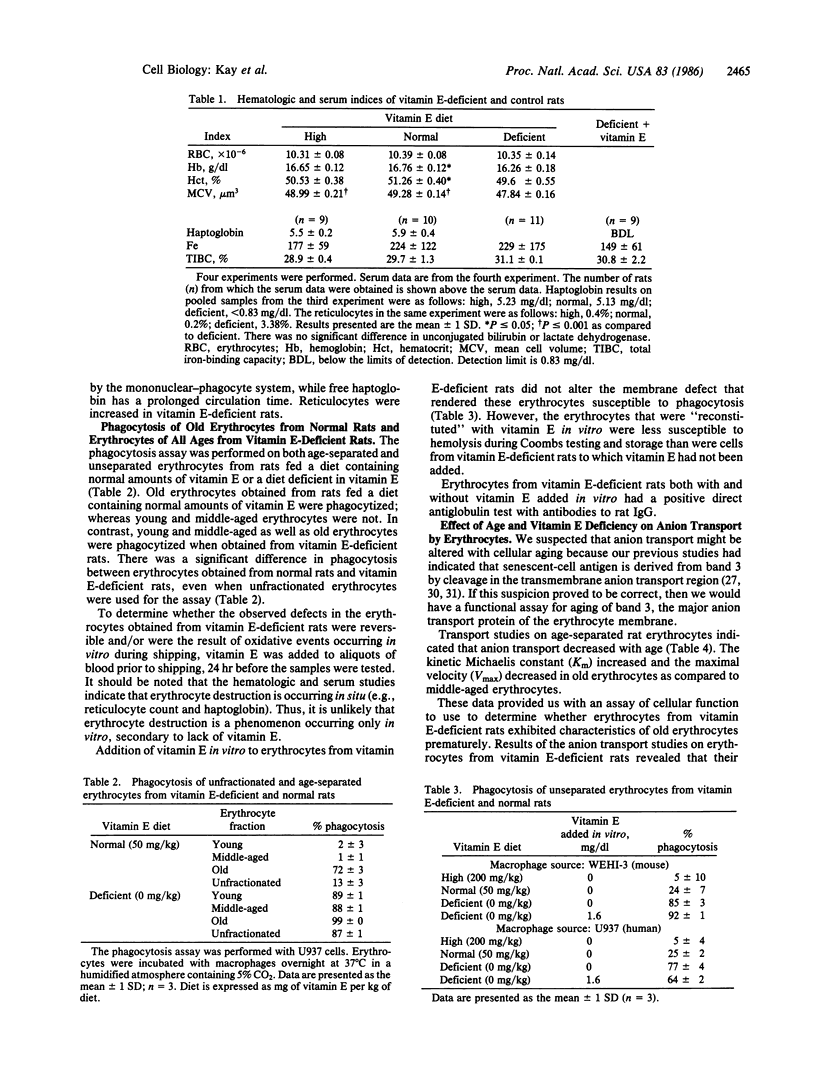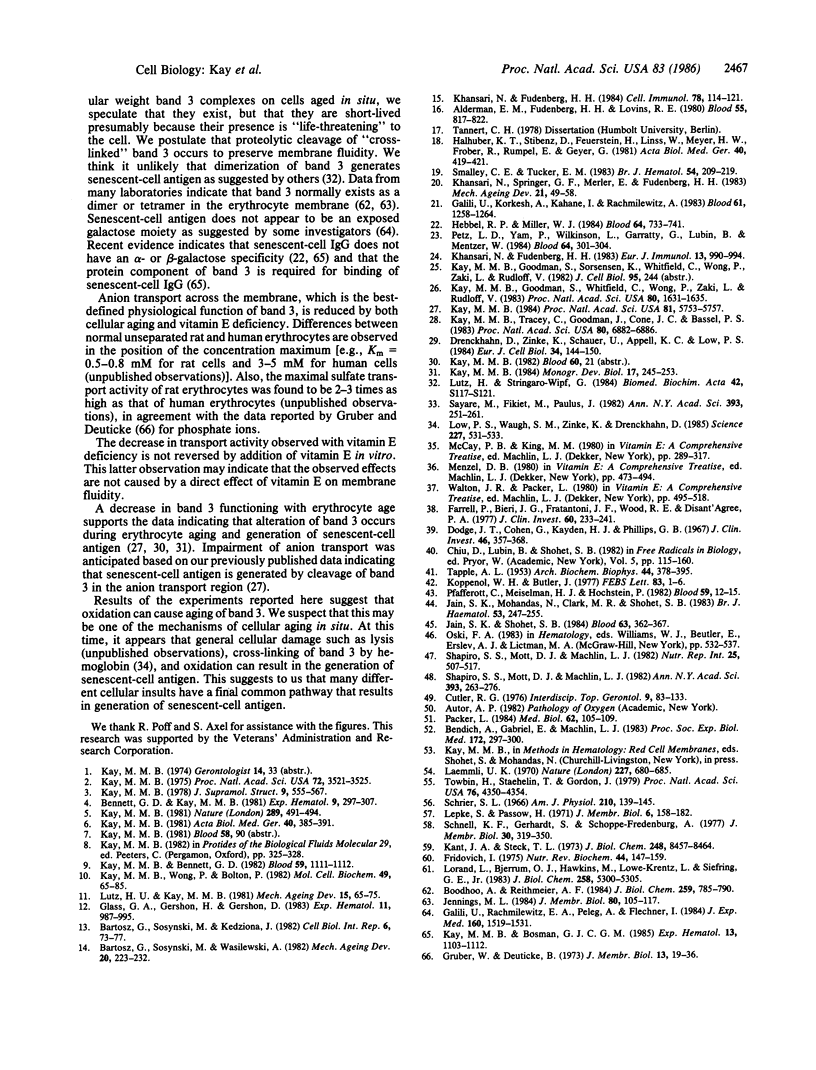Abstract
Senescent-cell antigen is a "neo-antigen" that appears on the surface of senescent cells and initiates IgG binding and cellular removal. As an approach to evaluating oxidation as a possible mechanism for generation of senescent-cell antigen, we studied erythrocytes from vitamin E-deficient rats. Vitamin E is localized primarily in cellular membranes. Its major role is the termination of free-radical chain reactions propagated by the polyunsaturated fatty acids of membrane propagated by the polyunsaturated fatty acids of membrane phospholipids. Results of our studies indicate that erythrocytes of all ages from vitamin E-deficient rats behave like old erythrocytes from normal rats, as determined by their susceptibility to phagocytosis, IgG binding, anion transport ability, and glyceraldehyde-3-phosphate dehydrogenase activity. Increased breakdown products of band 3 were observed with immunoblotting in membranes of erythrocytes from vitamin E-deficient rats. Breakdown products of band 3 are known to increase as cells age in normal individuals. The data suggest that oxidation may be a possible mechanism for erythrocyte aging and generation of senescent-cell antigen in vivo.
Full text
PDF




Images in this article
Selected References
These references are in PubMed. This may not be the complete list of references from this article.
- Alderman E. M., Fudenberg H. H., Lovins R. E. Binding of immunoglobulin classes to subpopulations of human red blood cells separated by density-gradient centrifugation. Blood. 1980 May;55(5):817–822. [PubMed] [Google Scholar]
- Bartosz G., Soszyński M., Kedziora J. Aging of the erythrocyte. VI. Accelerated red cell membrane aging in Down's syndrome? Cell Biol Int Rep. 1982 Jan;6(1):73–77. doi: 10.1016/0309-1651(82)90106-0. [DOI] [PubMed] [Google Scholar]
- Bartosz G., Soszyński M., Wasilewski A. Aging of the erythrocyte. XVII. Binding of autologous immunoglobulin G. Mech Ageing Dev. 1982 Nov;20(3):223–232. doi: 10.1016/0047-6374(82)90089-6. [DOI] [PubMed] [Google Scholar]
- Bendich A., Gabriel E., Machlin L. J. Differences in vitamin E levels in tissues of the spontaneously hypertensive and Wistar-Kyoto rats. Proc Soc Exp Biol Med. 1983 Mar;172(3):297–300. doi: 10.3181/00379727-172-41560. [DOI] [PubMed] [Google Scholar]
- Bennett G. D., Kay M. M. Homeostatic removal of senescent murine erythrocytes by splenic macrophages. Exp Hematol. 1981 Mar;9(3):297–307. [PubMed] [Google Scholar]
- Boodhoo A., Reithmeier R. A. Characterization of matrix-bound Band 3, the anion transport protein from human erythrocyte membranes. J Biol Chem. 1984 Jan 25;259(2):785–790. [PubMed] [Google Scholar]
- Dodge J. T., Cohen G., Kayden H. J., Phillips G. B. Peroxidative hemolysis of red blood cells from patients with abetalipoproteinemia (acanthocytosis). J Clin Invest. 1967 Mar;46(3):357–368. doi: 10.1172/JCI105537. [DOI] [PMC free article] [PubMed] [Google Scholar]
- Drenckhahn D., Zinke K., Schauer U., Appell K. C., Low P. S. Identification of immunoreactive forms of human erythrocyte band 3 in nonerythroid cells. Eur J Cell Biol. 1984 May;34(1):144–150. [PubMed] [Google Scholar]
- Farrell P. M., Bieri J. G., Fratantoni J. F., Wood R. E., di Sant'Agnese P. A. The occurrence and effects of human vitamin E deficiency. A study in patients with cystic fibrosis. J Clin Invest. 1977 Jul;60(1):233–241. doi: 10.1172/JCI108760. [DOI] [PMC free article] [PubMed] [Google Scholar]
- Fridovich I. Superoxide dismutases. Annu Rev Biochem. 1975;44:147–159. doi: 10.1146/annurev.bi.44.070175.001051. [DOI] [PubMed] [Google Scholar]
- Galili U., Korkesh A., Kahane I., Rachmilewitz E. A. Demonstration of a natural antigalactosyl IgG antibody on thalassemic red blood cells. Blood. 1983 Jun;61(6):1258–1264. [PubMed] [Google Scholar]
- Galili U., Rachmilewitz E. A., Peleg A., Flechner I. A unique natural human IgG antibody with anti-alpha-galactosyl specificity. J Exp Med. 1984 Nov 1;160(5):1519–1531. doi: 10.1084/jem.160.5.1519. [DOI] [PMC free article] [PubMed] [Google Scholar]
- Glass G. A., Gershon H., Gershon D. The effect of donor and cell age on several characteristics of rat erythrocytes. Exp Hematol. 1983 Nov;11(10):987–995. [PubMed] [Google Scholar]
- Gruber W., Deuticke B. Comparative aspects of phosphate transfer across mammalian erythrocyte membranes. J Membr Biol. 1973 Aug 30;13(1):19–36. doi: 10.1007/BF01868218. [DOI] [PubMed] [Google Scholar]
- Halbhuber K. J., Stibenz D., Feuerstein H., Linss W., Meyer H. W., Fröber R., Rumpel E., Geyer G. Defined rearrangement of the membrane of banked erythrocytes. Acta Biol Med Ger. 1981;40(4-5):419–421. [PubMed] [Google Scholar]
- Hebbel R. P., Miller W. J. Phagocytosis of sickle erythrocytes: immunologic and oxidative determinants of hemolytic anemia. Blood. 1984 Sep;64(3):733–741. [PubMed] [Google Scholar]
- Jain S. K., Mohandas N., Clark M. R., Shohet S. B. The effect of malonyldialdehyde, a product of lipid peroxidation, on the deformability, dehydration and 51Cr-survival of erythrocytes. Br J Haematol. 1983 Feb;53(2):247–255. doi: 10.1111/j.1365-2141.1983.tb02018.x. [DOI] [PubMed] [Google Scholar]
- Jain S. K., Shohet S. B. A novel phospholipid in irreversibly sickled cells: evidence for in vivo peroxidative membrane damage in sickle cell disease. Blood. 1984 Feb;63(2):362–367. [PubMed] [Google Scholar]
- Jennings M. L. Oligomeric structure and the anion transport function of human erythrocyte band 3 protein. J Membr Biol. 1984;80(2):105–117. doi: 10.1007/BF01868768. [DOI] [PubMed] [Google Scholar]
- Kant J. A., Steck T. L. Specificity in the association of glyceraldehyde 3-phosphate dehydrogenase with isolated human erythrocyte membranes. J Biol Chem. 1973 Dec 25;248(24):8457–8464. [PubMed] [Google Scholar]
- Kay M. M. Band 3, the predominant transmembrane polypeptide, undergoes proteolytic degradation as cells age. Monogr Dev Biol. 1984;17:245–253. [PubMed] [Google Scholar]
- Kay M. M., Bennett G. D. Isolation and characterization of a senescent cell antigen. Blood. 1982 May;59(5):1111–1112. [PubMed] [Google Scholar]
- Kay M. M., Bosman G. J. Naturally occurring human "antigalactosyl" IgG antibodies are heterophile antibodies recognizing blood-group-related substances. Exp Hematol. 1985 Dec;13(11):1103–1112. [PubMed] [Google Scholar]
- Kay M. M., Goodman S. R., Sorensen K., Whitfield C. F., Wong P., Zaki L., Rudloff V. Senescent cell antigen is immunologically related to band 3. Proc Natl Acad Sci U S A. 1983 Mar;80(6):1631–1635. doi: 10.1073/pnas.80.6.1631. [DOI] [PMC free article] [PubMed] [Google Scholar]
- Kay M. M. Isolation of the phagocytosis-inducing IgG-binding antigen on senescent somatic cells. Nature. 1981 Feb 5;289(5797):491–494. doi: 10.1038/289491a0. [DOI] [PubMed] [Google Scholar]
- Kay M. M. Localization of senescent cell antigen on band 3. Proc Natl Acad Sci U S A. 1984 Sep;81(18):5753–5757. doi: 10.1073/pnas.81.18.5753. [DOI] [PMC free article] [PubMed] [Google Scholar]
- Kay M. M. Mechanism of removal of senescent cells by human macrophages in situ. Proc Natl Acad Sci U S A. 1975 Sep;72(9):3521–3525. doi: 10.1073/pnas.72.9.3521. [DOI] [PMC free article] [PubMed] [Google Scholar]
- Kay M. M. Role of physiologic autoantibody in the removal of senescent human red cells. J Supramol Struct. 1978;9(4):555–567. doi: 10.1002/jss.400090409. [DOI] [PubMed] [Google Scholar]
- Kay M. M., Sorensen K., Wong P., Bolton P. Antigenicity, storage, and aging: physiologic autoantibodies to cell membrane and serum proteins and the senescent cell antigen. Mol Cell Biochem. 1982 Nov 26;49(2):65–85. doi: 10.1007/BF00242486. [DOI] [PubMed] [Google Scholar]
- Kay M. M. The IgG autoantibody binding determinant appearing on senescent membranes residues on a 62000 MW peptide. Acta Biol Med Ger. 1981;40(4-5):385–391. [PubMed] [Google Scholar]
- Kay M. M., Tracey C. M., Goodman J. R., Cone J. C., Bassel P. S. Polypeptides immunologically related to band 3 are present in nucleated somatic cells. Proc Natl Acad Sci U S A. 1983 Nov;80(22):6882–6886. doi: 10.1073/pnas.80.22.6882. [DOI] [PMC free article] [PubMed] [Google Scholar]
- Khansari N., Fudenberg H. H. Immune elimination of aging platelets by autologous monocytes: role of membrane-specific autoantibody. Eur J Immunol. 1983 Dec;13(12):990–994. doi: 10.1002/eji.1830131207. [DOI] [PubMed] [Google Scholar]
- Khansari N., Fudenberg H. H. Phagocytosis of senescent erythrocytes by autologous monocytes: requirement of membrane-specific autologous IgG for immune elimination of aging red blood cells. Cell Immunol. 1983 May;78(1):114–121. doi: 10.1016/0008-8749(83)90264-2. [DOI] [PubMed] [Google Scholar]
- Khansari N., Springer G. F., Merler E., Fudenberg H. H. Mechanisms for the removal of senescent human erythrocytes from circulation: specificity of the membrane-bound immunoglobulin G. Mech Ageing Dev. 1983 Jan;21(1):49–58. doi: 10.1016/0047-6374(83)90015-5. [DOI] [PubMed] [Google Scholar]
- Koppenol W. H., Butler J. Mechanism of reactions involving singlet oxygen and the superoxide anion. FEBS Lett. 1977 Nov 1;83(1):1–6. doi: 10.1016/0014-5793(77)80628-5. [DOI] [PubMed] [Google Scholar]
- Laemmli U. K. Cleavage of structural proteins during the assembly of the head of bacteriophage T4. Nature. 1970 Aug 15;227(5259):680–685. doi: 10.1038/227680a0. [DOI] [PubMed] [Google Scholar]
- Lorand L., Bjerrum O. J., Hawkins M., Lowe-Krentz L., Siefring G. E., Jr Degradation of transmembrane proteins in Ca2+-enriched human erythrocytes. An immunochemical study. J Biol Chem. 1983 Apr 25;258(8):5300–5305. [PubMed] [Google Scholar]
- Low P. S., Waugh S. M., Zinke K., Drenckhahn D. The role of hemoglobin denaturation and band 3 clustering in red blood cell aging. Science. 1985 Feb 1;227(4686):531–533. doi: 10.1126/science.2578228. [DOI] [PubMed] [Google Scholar]
- Lutz H. U., Kay M. M. An age-specific cell antigen is present on senescent human red blood cell membranes. A brief note. Mech Ageing Dev. 1981 Jan;15(1):65–75. doi: 10.1016/0047-6374(81)90008-7. [DOI] [PubMed] [Google Scholar]
- Lutz H. U., Stringaro-Wipf G. Senescent red cell-bound IgG is attached to band 3 protein. Biomed Biochim Acta. 1983;42(11-12):S117–S121. [PubMed] [Google Scholar]
- Packer L. Vitamin E, physical exercise and tissue damage in animals. Med Biol. 1984;62(2):105–109. [PubMed] [Google Scholar]
- Petz L. D., Yam P., Wilkinson L., Garratty G., Lubin B., Mentzer W. Increased IgG molecules bound to the surface of red blood cells of patients with sickle cell anemia. Blood. 1984 Jul;64(1):301–304. [PubMed] [Google Scholar]
- Pfafferott C., Meiselman H. J., Hochstein P. The effect of malonyldialdehyde on erythrocyte deformability. Blood. 1982 Jan;59(1):12–15. [PubMed] [Google Scholar]
- Sayare M., Fikiet M., Paulus J. Effect of vitamin E on the binding of hemoglobin to the red cell membrane. Ann N Y Acad Sci. 1982;393:251–262. doi: 10.1111/j.1749-6632.1982.tb31266.x. [DOI] [PubMed] [Google Scholar]
- Schnell K. F., Gerhardt S., Schöppe-Fredenburg A. Kinetic characteristics of the sulfate self-exchange in human red blood cells and red blood cell ghosts. J Membr Biol. 1977 Jan 28;30(4):319–350. doi: 10.1007/BF01869675. [DOI] [PubMed] [Google Scholar]
- Schrier S. L. Organization of enzymes in human erythrocyte membranes. Am J Physiol. 1966 Jan;210(1):139–145. doi: 10.1152/ajplegacy.1966.210.1.139. [DOI] [PubMed] [Google Scholar]
- Shapiro S. S., Mott D. J. Alterations of enzymes in the red blood cell membrane in vitamin E deficiency. Ann N Y Acad Sci. 1982;393:263–276. doi: 10.1111/j.1749-6632.1982.tb31267.x. [DOI] [PubMed] [Google Scholar]
- Smalley C. E., Tucker E. M. Blood group A antigen site distribution and immunoglobulin binding in relation to red cell age. Br J Haematol. 1983 Jun;54(2):209–219. doi: 10.1111/j.1365-2141.1983.tb02089.x. [DOI] [PubMed] [Google Scholar]
- TAPPEL A. L. The mechanism of the oxidation of unsaturated fatty acids catalyzed by hematin compounds. Arch Biochem Biophys. 1953 Jun;44(2):378–395. doi: 10.1016/0003-9861(53)90056-3. [DOI] [PubMed] [Google Scholar]
- Towbin H., Staehelin T., Gordon J. Electrophoretic transfer of proteins from polyacrylamide gels to nitrocellulose sheets: procedure and some applications. Proc Natl Acad Sci U S A. 1979 Sep;76(9):4350–4354. doi: 10.1073/pnas.76.9.4350. [DOI] [PMC free article] [PubMed] [Google Scholar]




